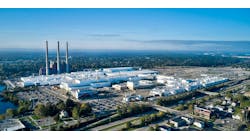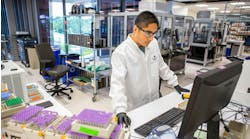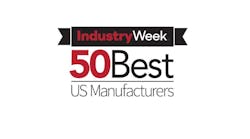There is a common mindset in manufacturing that it’s easier to invest in the latest technologies when your company is growing. When you are not growing, the mindset is often to stay with what you have.
Common barriers for manufacturers (and many other companies) include:
- They can be reluctant to change longstanding processes that work and everyone understands.
- They are hesitant to invest in technology while dealing with constraints on their production capacity and cost pressures from customers.
- Adopting digital technologies can be daunting because of the need to learn new skills and develop processes.
But there is a case to be made for automation as a path for growth and profitability, even at the smallest companies. With that in mind, the Oklahoma Manufacturing Alliance (OMA), developed an Automation Roadshow so that manufacturers from across the state could get a real-world look at advanced manufacturing equipment and learn from industry experts about trends and the integration of production technology.
“For small and medium-sized manufacturers, integrating advanced technologies isn’t just about staying relevant,” says Rajesh Krishnamurthy, OMA’s director of technical services. “It’s about optimizing the future of their production, where smart systems amplify efficiency and pave the way for sustained growth in a rapidly evolving industrial landscape.”
In fact, for some manufacturers in Oklahoma, the tipping point for adopting technology came when people in the organization saw automation as the only path to growth. Here is a look at what else OMA has learned and shared.
Find Ways to Learn About Automation and Technology Applications
It’s often difficult for manufacturers to launch their automation journey, so it makes sense to start with something simple. The first step is to find ways to engage so that you can see and learn from someone’s automation success. Educate yourself on what is referred to as simple automation for repetitive tasks, such as material handling on conveyor lines, assembly, inspection, packaging, or palletting. Research costs and ROI. Learn about funding help and financial incentives available in your area.
The regularly scheduled Roadshows are coordinated by Sharon Harrison, OMA's Director of Workforce and Community Partnerships, with input from the Advanced Technology & Innovation Committee. The events include networking, programming,and demonstration. OMA also has a learning lab and mobile lab for manufacturers to learn about technology adoption and see proof of concepts through virtual reality and augmented reality. OMA is part of the MEP National Network, which has offices in every state and Puerto Rico. Many local MEP Centers offer technology demonstrations and roadshows; contact your local Center to learn what is available near you.
Prepare Your People for Automation
Some people are technically savvy and immediately see potential in automation, but others remain skeptical that automation will eliminate their jobs.
“For manufacturers, adopting advanced technology is an essential investment in their workforce,” Krishnamurthy says. “Embracing smart technologies not only enhances efficiency but empowers the workforce, fostering a dynamic environment where innovation and collaboration can redefine the future of industry.”
You must show your staff that they have no reason to fear automation. Engage with your employees to hear their concerns, and assure them that people will be at the center of any initiative. You will want to show your staff that automation is:
- Replacing repetitive tasks that no one wants to do and allowing them to do higher value work
- Offering new career opportunities with better paying jobs so they can see what’s in it for them
- An opportunity for training and career development
Start With Lean Principles and Processes
Automation itself is based on Lean manufacturing principles – identifying value and creating a repeatable, efficient process. OMA’s process begins with a comprehensive and proprietary technology assessment and includes ways to identify organizational challenges.
The process also includes information flow mapping, a supply chain risk assessment, and various other assessments. A key element is succession planning, not just in the business leadership but for operational positions on the facility floor. Who is going to do what job, and who will be trained to be backups. Again, put people at the center of the initiative.
Simple Automation Success Stories From Oklahoma
Integration of Collaborative Robots
Rise Armament was struggling with the manual process of polishing parts, with a growing failure rate that was jeopardizing a contract. It also was a bottleneck in the operation. They integrated a lightweight robot arm, which immediately improved quality and increased output from 200 parts a day to 2,000. The person who previously did the manual polishing was given a better job. The workers saw the benefit and embraced the technology. The company now has seven cobots and has grown by 19 people.
Simulation Shows How to Use Additive Manufacturing and Robotic Welding
Pelco Products manufactures traffic and utility hardware – brackets, lighting, pedestrian push buttons, copper theft deterrents, and hundreds of other products. They knew they were overdue to modernize operations, so they used virtual simulations to test new technologies and production movement without having the new equipment onsite. Optimal schemes were established for various functions, new equipment was purchased, and those processes were transferred to the real-world factory floor. They have integrated additive manufacturing stations and robotic welding cells into their operation.
Upgrading Equipment Helps Meet Customer Demands and Provides Flexibility
Teal-Jones Lumber had a long history of success, but they knew that upgrading their equipment would allow them to better meet a wider range of customer requirements. They also used modeling to revise the plant layout without having to move equipment to test out their premise. They purchased advanced manufacturing equipment to launch six new product lines without having to use additional space. The equipment and new layout also provide more flexibility for future expansion.
Your Local MEP Center Can Help You With Tech Adoption
Your local MEP Center has experts to help you assess your advanced manufacturing technology needs and opportunities. They can connect you with tech demonstrations and networking opportunities near you. Let’s talk.
About the Author
Kinnee Tilly
Vice President of Business Development and Operations, Oklahoma Manufacturing Alliance
Kinnee has vast experience in business, industry and economic development. She coordinates a field staff of 20 for OMA with offices in communities across the state, while developing relationships with numerous sponsors, partners and stakeholders. Kinnee also is Chair of Select Oklahoma, a statewide economic development organization. She previously was a vice president for Indian Capital Technology Center and was a senior vice president for the Broken Arrow Chamber of Commerce.
Sponsored by:




